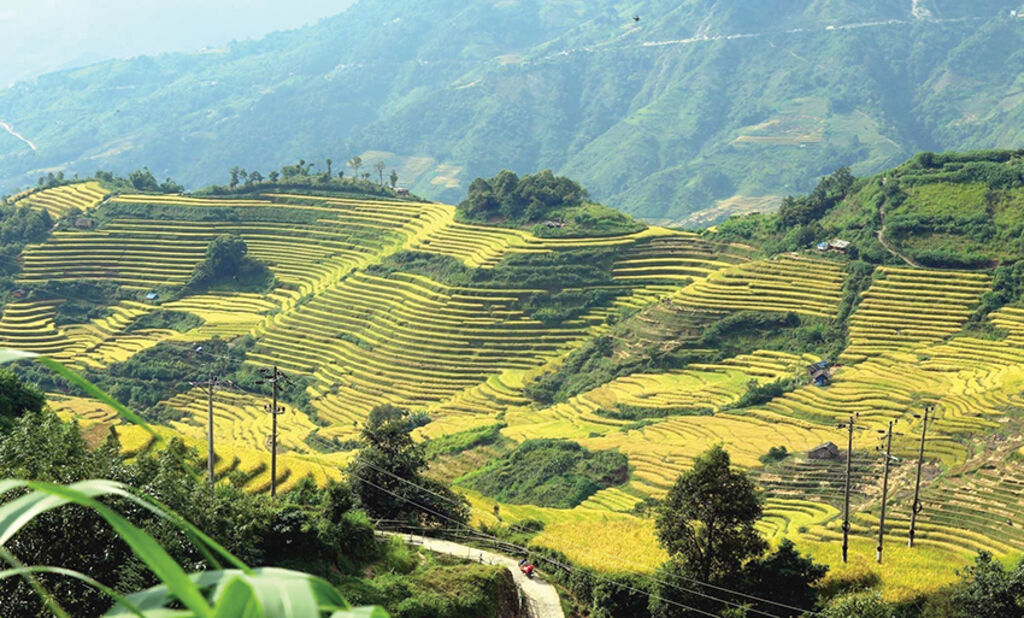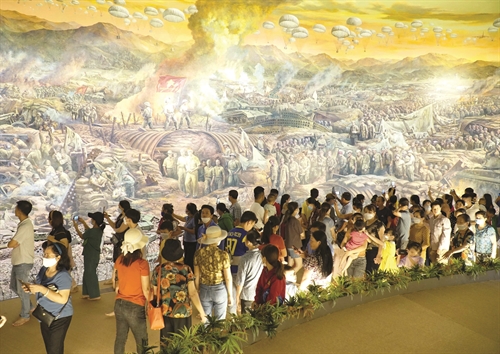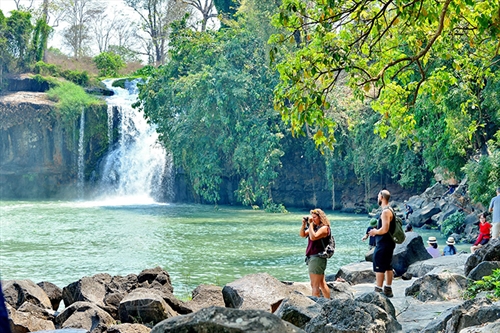 |
| Terrace fields in the northwestern mountainous region during harvest time__Photo: Quy Trung/VNA |
Lai Chau, a northwestern province that shares a borderline of more than 265 kilometers with China, is calling for investment in its infrastructure, ecological and hi-tech agricultural economy and tourism so as to become a province with a medium-level development in the northern midland and mountainous region by 2030.
Lai Chau is bordered by China’s Yunnan province to the north, Lao Cai and Yen Bai provinces to the east, Dien Bien province to the west and Son La province to the south.
The province’s transport and tourism infrastructure facilities have received special attention of not only provincial authorities but also the central government. The Prime Minister has recently requested ministries and sectors to actively support Lai Chau province in building infrastructure in order to ensure the connectivity within the province, among localities in the northwestern region and between the region with remaining parts of the country as well as foreign countries. Specifically, the cabinet leader has asked the provincial authorities to study and complete the construction of the interchange connecting the Noi Bai-Lao Cai expressway and Lai Chau city and Mu La Thang border gate as soon as possible, propose and arrange funds for investment in the 1.7 kilometer road tunnel through Khau Co pass situated in Lai Chau and Lao Cai provinces, and thoroughly study and assess the feasibility of the Lai Chau airport project to be implemented in the form of public-private partnership (PPP).
The infrastructure development will help open up new development spaces such as hi-tech agriculture and tourism associated with the preservation and bringing into play of cultural identities of the province’s ethnic minority groups.
With temperate climate range and various types of soil, the province is favorable for development of diverse food crops, fruit trees, medicinal plants and industrial plants of high economic value, including ginseng, rubber, tea, cinnamon and macadamia. At present, the province boasts around 3,900 hectares of rice (annually producing 20,300 tons); 9,786 hectares of tea plantations (annually producing 54,000 tons); 12,940 hectares of rubber trees (annually producing 10,800 tons of dry latex); and more than 7,300 hectares of macadamia (annually producing almost 4,700 tons).
To date, the province has 171 products with three stars or higher in the One Commune, One Product (OCOP) program. Under this program, the province is calling for investment in processing plants associated with material zones, and developing value chains from production and processing to consumption and domestic and export markets.
In the coming time, it will concentrate on growing more medicinal plants, improving the quality of OCOP products, and developing ginseng plants, concentrated animal husbandry and freshwater fish rearing.
Apart from agriculture, the province will develop tourism into a spearhead economic sector. The hospitality sector will continue building unique and high-quality tourism products imbued with local cultural identities and exploiting potential of the Sin Ho plateau. In addition, the province will further improve tourism service and product quality and promote realistic and vivid images of its community-based tourism sites and seek new tourism markets.
In 2023, the province enhanced its cooperation with neighboring provinces in creating new tourism products and raising its highlight and differences in the northwestern region’s discovery itinerary. It also actively took part in the Northwest Quintessence Festival in Ho Chi Minh City, and the Northwest Tourism-Culture Week in Can Tho city and the Vietnam International Travel Mart (VITM) in Hanoi in order to promote the province’s image.
Specifically, it developed tours to Thu Lum terrace rice fields, Tham Phe and Than Uyen fishing villages, Ban Chat and Huoi Quang hydropower reservoirs, and trekking tours to Pu Si Lung, Pu Ta Leng, Ky Quan San and Ta Lien Son mountain peaks.
In order to attract more foreign direct investment (FDI), the provincial authorities have shown their determination in simplifying administrative procedures to shorten the period of processing procedures for land allocation, investment, construction, planning and environmental protection assessment. They will promptly tackle any difficulties and problems facing investors in order to attract more FDI in PPP projects in the three aforesaid sectors.-
| Provincial facts Land area: more than 9,000 sq. km Administrative units: Lai Chau city and seven districts of Muong Te, Sin Ho, Nam Nhun, Tam Duong, Phong Tho, Tan Uyen and Than Uyen Population: around 490,000 Ethnic groups: 20 ethnic groups, including Thai (32.3 percent), H’Mong (21.5 percent), Dao (13.2 percent), Kinh (Viet) (15.3 percent), etc. Socio-economic figures - Export turnover: USD 8.43 million in 2023 - Main exports: Assorted tea products - Gross regional domestic product (GRDP): VND 13.7 trillion (USD 572 million) in 2023 - Border economic zone: Ma La Thung in Phong Tho district - Rate of poor households: 26.4 percent in 2023 Tourism - Famous tourist attractions: + O Quy Ho mountain pass + Sin Ho plateau + Tan Uyen tea plantation + Pu Si Lung, Pu Ta Leng and Ky Quan San - three of Vietnam’s 10 tallest mountain peaks + Muong Te nature reserve with 542 plant species, including 57 species listed in Vietnam Red Book, seven species in IUCN Red List and 22 species endemic to the northwestern region + Muong Than rice field + Pu Sam Cap cave + Si Thau Chai village of the Dao - Traditional crafts: blacksmith, brocade, rattan and bamboo weaving, and embroidery - Travellers: some 442,000 in 2023 - Tourism turnover: VND 610 billion (USD 25.4 million) in 2023 - Xoe - traditional dance art and Then singing - a genre of folk art combining literature, music and dance - of the Thai - UNESCO Intangible Cultural Heritages of Humanity - Festivals + Chieng (gong) festival of the Thai in the first half of the first month of the lunar calendar + The festival of traditional then singing accompanied by Tinh (gourd lute) instrument performance + Gau Tao festival of the H’Mong ethnic minority held on the 15th of the first month of the lunar calendar (Source: https://laichau.gov.vn/, https://dulich.laichau.gov.vn/) |
|---|









